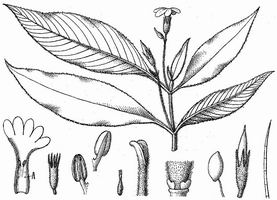
Engl., Bot. Jahrb. Syst. 58: fig. 7 (1923), orig. illustration
Full name and orig. publication: Sepikea Schltr., Bot. Jahrb. Syst. 58: 306 (1 July 1923).
Etymology: Named after the locality, where the plant was found: the area of River Sepik in New Guinea.
Synonyms: -
Infrafamilial position: Didymocarpoid Gesneriaceae - "Advanced Asiatic and Malesian genera" (Weber 2004).
Description: Large terrestrial herbs. Stem unbranched, terete. Leaves spaced, opposite (somewhat anisophyllous?), with short petiole, lamina lanceolate-elliptical. Stem and leaves with soft, dense indumentum of brownish-yellowish hairs. Cymes few-flowered, with long peduncle. Sepals fused (c. to 1/2) to form a cylindrical-tubular calyx, lobes equal. Corolla tubular-infundibuliform, tube c. 2x as long as calyx, limb with subequal, patent, oval lobes, white. Fertile stamens two (as to the original description the posterior ones) , included, filaments inserted at middle of corolla tube. Staminodes lacking (?). Nectary annular, shallowly lobed. Ovary cylindrical-conical, stigma bifid. Fruit short-cylindrical, indehiscent.
Chromosome number: Unknown.
Type and only species: Sepikea cylindrocarpa Schltr.
Species names (incl. publication and synonyms): See Skog, L.E. & J.K. Boggan. 2005: World checklist of Gesneriaceae: http://persoon.si.edu/Gesneriaceae/Checklist.
Distribution: New Guinea (Sepik area).
Ecology: Probably similar to Cyrtandra.
Notes: The genus/species is very badly known. Its main distinctive feature separating it from Cyrtandra is the posterior fertile stamen pair, which, however, may be a misobservation (Burtt 1998a).
Bibliography: See Skog, L.E. & J.K. Boggan. 2005. Bibliography of the Gesneriaceae. 2nd edition: http://persoon.si.edu/Gesneriaceae/Bibliography.
Illustrations:
 |
Sepikea cylindrocarpa
Schltr., type and only species
Engl., Bot. Jahrb. Syst. 58: fig. 7 (1923), orig. illustration |
last modified: 2007-07-13